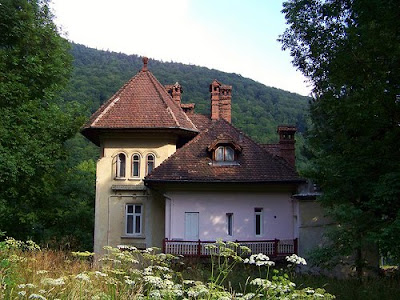
Though it was far too short and hectic for my taste, I was grateful for the chance to recently travel to Europe. Part of the trip consisted of revisiting old haunts while the other entailed exploring a new place of which I had lots of curiosity for. My itinerary through the former East Germany and Romania offered a vivid glimpse of the changes that have occurred since the Communist control. In the case of reunified Germany (or more accurately the Western acquisition of the East) a massive transfer of wealth from the West was infused to rebuild an entire East to the point that it is has become more 'modern' than its Western counerpart. Romania, which went through the typical motions of electing ex-communists before pursuing pro-market and pro-American foreign policies, is rebuilding from a much lower base and a more devastating architectural legacy left by its swiftly executed dictator, yet it it still is blessed with gorgeous landscapes and endearing traditional architecture. Though I've been living in the U.S. for a long time, my background of having lived in Europe and maintaining close family ties there have colored my impression during my travels. It is not enough for me enjoy Europe's visual delights without trying to get a grasp of what goes on beneath it all. If there is one lesson from this trip, it is that what is built and the life that goes on within it are not always harmonious. In one place, what was built was but an elegant shell concealing social rust and decay. In the other, a rusting and decayed shell was giving way to a recovered social vitality and optimism.
Federal State of Saxony, Germany
 I returned to this area of Germany for the first time in 12 years, visiting friends that I have known since my year as an exchange student three years after the reunification of East and West (I also share my impressions of the place here). Upon arriving to my final destination in the beautiful hilly countryside outside Chemnitz (pop. circa 300,000), the physical changes to this area was striking. Whereas I had left Saxony with memories of crumbling roads, dilapidated and dull gray building facades, old Trabants and Wartburgs (defunct East-German car brands) and dreary Soviet-era architecture, what I now saw the opposite: the roads were the newest (and fastest) in all of Germany, facades were colorful and painstakingly restored, Trabants were almost nowhere to be seen, the ugly towers were re-clad with aluminum, glass and balconies. Overall infrastructure is well known to be newer than in the West, with better phone lines, broadband and power grids. Giant wind turbines dotted the landscape, standing majestically on the wheat-covered hills (surely the farmers were remunerated generously for them).
I returned to this area of Germany for the first time in 12 years, visiting friends that I have known since my year as an exchange student three years after the reunification of East and West (I also share my impressions of the place here). Upon arriving to my final destination in the beautiful hilly countryside outside Chemnitz (pop. circa 300,000), the physical changes to this area was striking. Whereas I had left Saxony with memories of crumbling roads, dilapidated and dull gray building facades, old Trabants and Wartburgs (defunct East-German car brands) and dreary Soviet-era architecture, what I now saw the opposite: the roads were the newest (and fastest) in all of Germany, facades were colorful and painstakingly restored, Trabants were almost nowhere to be seen, the ugly towers were re-clad with aluminum, glass and balconies. Overall infrastructure is well known to be newer than in the West, with better phone lines, broadband and power grids. Giant wind turbines dotted the landscape, standing majestically on the wheat-covered hills (surely the farmers were remunerated generously for them).
 I returned to this area of Germany for the first time in 12 years, visiting friends that I have known since my year as an exchange student three years after the reunification of East and West (I also share my impressions of the place here). Upon arriving to my final destination in the beautiful hilly countryside outside Chemnitz (pop. circa 300,000), the physical changes to this area was striking. Whereas I had left Saxony with memories of crumbling roads, dilapidated and dull gray building facades, old Trabants and Wartburgs (defunct East-German car brands) and dreary Soviet-era architecture, what I now saw the opposite: the roads were the newest (and fastest) in all of Germany, facades were colorful and painstakingly restored, Trabants were almost nowhere to be seen, the ugly towers were re-clad with aluminum, glass and balconies. Overall infrastructure is well known to be newer than in the West, with better phone lines, broadband and power grids. Giant wind turbines dotted the landscape, standing majestically on the wheat-covered hills (surely the farmers were remunerated generously for them).
I returned to this area of Germany for the first time in 12 years, visiting friends that I have known since my year as an exchange student three years after the reunification of East and West (I also share my impressions of the place here). Upon arriving to my final destination in the beautiful hilly countryside outside Chemnitz (pop. circa 300,000), the physical changes to this area was striking. Whereas I had left Saxony with memories of crumbling roads, dilapidated and dull gray building facades, old Trabants and Wartburgs (defunct East-German car brands) and dreary Soviet-era architecture, what I now saw the opposite: the roads were the newest (and fastest) in all of Germany, facades were colorful and painstakingly restored, Trabants were almost nowhere to be seen, the ugly towers were re-clad with aluminum, glass and balconies. Overall infrastructure is well known to be newer than in the West, with better phone lines, broadband and power grids. Giant wind turbines dotted the landscape, standing majestically on the wheat-covered hills (surely the farmers were remunerated generously for them).